|
|
Updated as per personal communication with Antoine Guyonnet (Constanza Michelle: Yokadouma, Est Province, Cameroon; February 2, 2010); April 28, 2010
Updated as per personal communication with Clay Shiroma (Haleiwa, Oahu, Hawaii, May 2011); May 15, 2011
Updated as per personal communication with Nancy Sommers (Kona, Hawaii, December 14, 2011); December 20, 2011
Updated as per personal communication with Kathleen Marchetti (Makawao, Maui, Hawaii, August 7, 2012); August 8, 2012
Updated as per personal communication with Karen Christensen (Kanoehe, Oahu, Hawaii, December 10, 2012); December 10, 2012
Updated as per personal communication with Sherm Warner (Kamuela, Big Island, Hawaii, April 10, 2014); April 11, 2014
Updated as per personal communication with Melita Counta (larvae on Nerium oleander, Nicosia, Cyprus, June 13, 2014); June 14, 2014
Updated as per personal communication with Maris Asato (adult moth, Hilo, Big Island, Hawaii, February 15, 2018); February 16, 2018
Updated as per personal communication with River Seki and Mom D. (adult moth, Mililani, Oahu, Hawaii, October 1, 2018); October 13, 2018
|
Deilephila nerii
(Linnaeus, 1758)
Oleander Hawk Moth
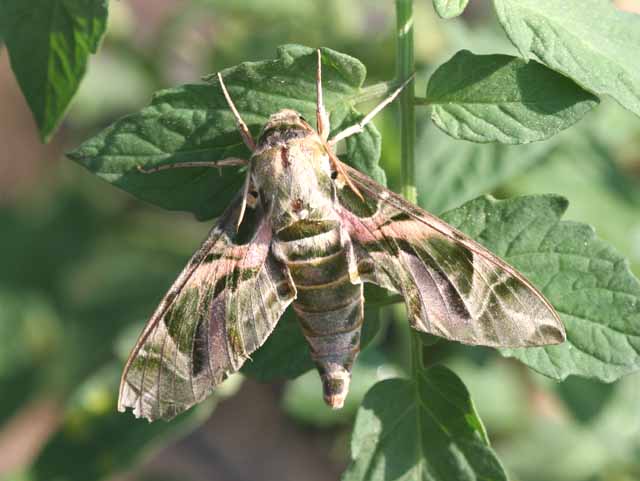
Deilephila nerii or Daphnis nerii, courtesy of
Jim Snyder,
Kailua-Kona, Hawaii, December 24, 2004.
Almost all the pictures and information on this page come from Tony Pittaway.
This site has been created by Bill Oehlke,
Comments, suggestions and/or additional information are welcomed by Bill.
TAXONOMY:
Family: Sphingidae, Latreille, 1802
Subfamily: Macroglossinae, Harris, 1839
Tribe: Macroglossini, Harris, 1839
Genus: Deilephila ...........
Species: nerii (Linnaeus, 1758)
|
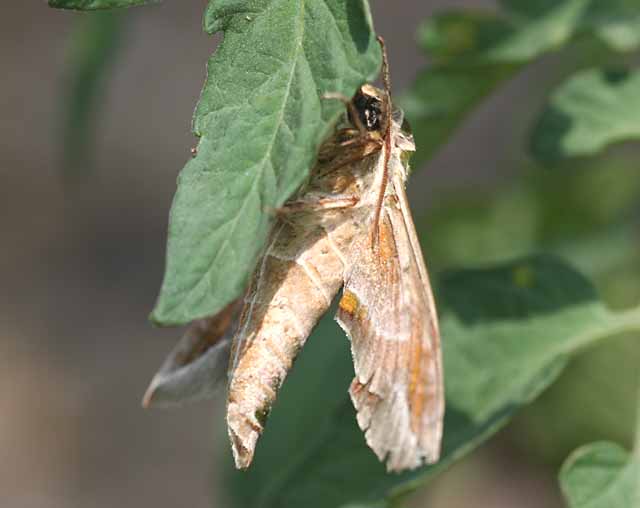
Deilephila nerii or Daphnis nerii, ventral, courtesy of
Jim Snyder,
Kailua-Kona, Hawaii, December 24, 2004.
DISTRIBUTION:
The Oleander Hawk Moth,
Deilephila nerii or Daphnis nerii (Wing span: 90--110mm)
is primarily associated with "the southern Mediterranean region,
North Africa and the Middle East
to Afghanistan (Ebert, 1969). Along the Mediterranean, there is no
clear distinction between resident and migrant populations. Permanent
populations exist in suitable locations in Sicily, Crete and Cyprus;
however, over a number of favourable years further colonies may be
established in those islands and also in southern Italy and southern
Greece, all of which die out during a hard winter."
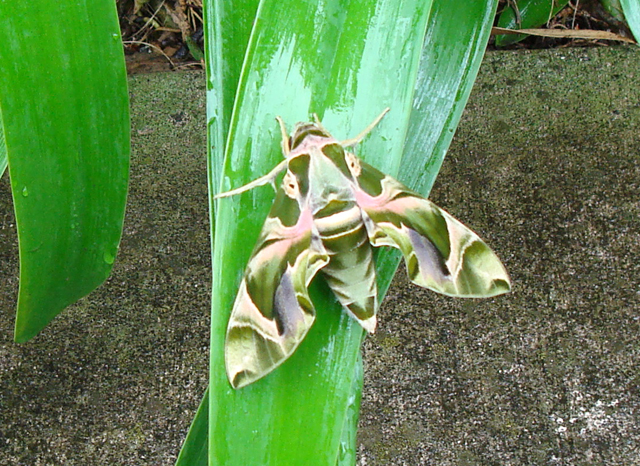
Deipephila nerii Maui, Hawaii, February 2008, courtesy of Sean Demarre.
"Extra-limital range. From Afghanistan eastward to south-east Asia and the Philippines; as a migrant, it penetrates
northwards into central Europe and central southern Asia. In Africa it ocurs at least as far south as southern Cameroon.
In 1974, this species was recorded as having established itself in Hawaii (Beardsley, 1979).
Deilephila nerii, Maui, Hawaii, March 2005, courtesy of John Steele, via Sally Knight-Valencia. |
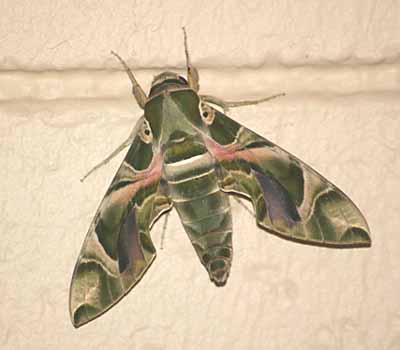 |
Deilephila nerii "rests by day, either on a solid surface or suspended among foliage with which it blends; the head is tucked in,
with the thorax and abdomen raised off the underlying substrate.
Most emerge late in the evening but do not take flight until just before dawn, to feed avidly from such flowers as Nicotiana, Petunia,
Lonicera, Saponaria and Mirabilis. Thereafter, flight periods are mainly just after dusk and before dawn. Under warm conditions, adults
are extremely wary and, if disturbed, will take flight even during daylight hours."
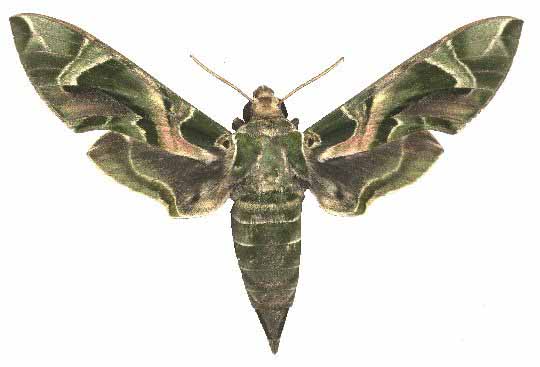
FLIGHT TIMES AND FOOD PLANTS:
The Oleander Hawk Moth probably flies from May to September to December (NS) in four or five generations.
I have received reports of adult moths in Hawaii in February, March, April, May and December. There may be additional flight months.
Visit Deilephila nerii, Kona, Hawaii, December 14, 2011, courtesy of Nancy
Sommers.
Visit Deilephila nerii, Hilo, Big Island, Hawaii, February 15, 2018,
courtesy of Maris Asato.
Visit Deilephila nerii, Mililani, Oahu, Hawaii, October 1, 2018,
courtesy of River Seki and Mom D.
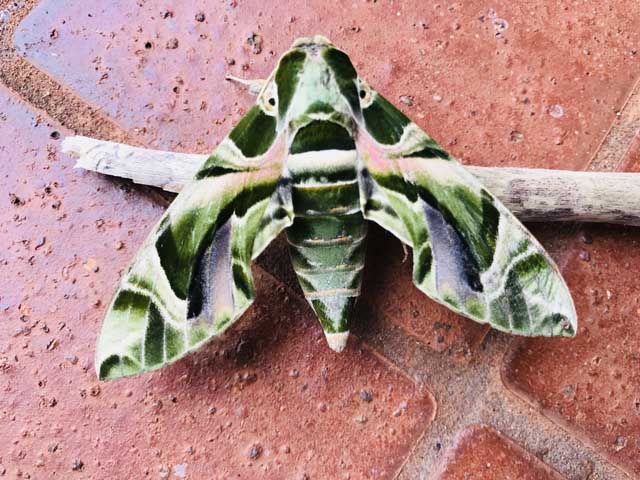
Deilephila nerii, Mililani, Oahu, Hawaii,
October 1, 2018, courtesy of River Seki and his mom, D.
Many thanks to River Seki who spotted the D. nerii directly above. His mom, D., photographed it and sent it to me.
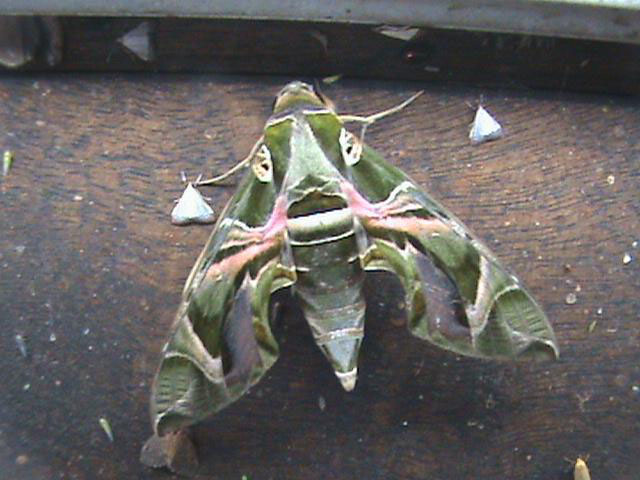
Daphnis nerii, Yokadouma, Est Province, Cameroon,
February 2, 2010, courtesy of Constanza Michelle, via Antoine Guyonnet.
It is found throughout its resident range between May and October; across southern Europe, sometimes in July but usually in
August/September. It is rarely found north of the Alps.
The major host are the flowers and young leaves of Nerium oleander.
Deilephila nerii or Daphnis nerii, courtesy of Tony Pittaway.
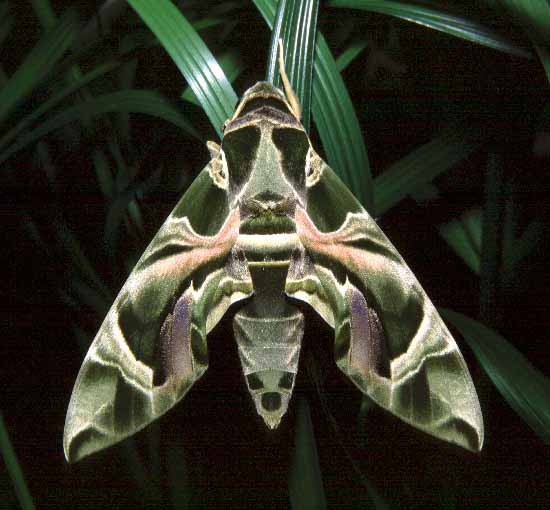
Minor hostplants are Vinca, Vitis, Gardenia, Asclepias, Jasminum, Trachelospermum, Amsonia, Carissa, Tabernaemontana, Mangifera,
Rhazya, Adenium, Catharanthus, Ipomoea and Thevetia.
Larvae will also feed on Ligustrum ovalifolium in captivity.
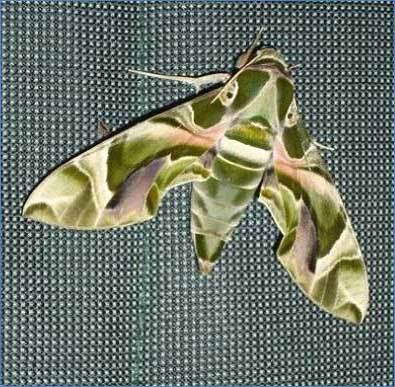
Deilephila nerii, Haleiwa, Oahu, Hawaii,
May 2011, courtesy of Clay Shiroma.
Kathleen Marchetti sends the following note and images, August 8, 2012:
"Aloha,
"I live on Maui in Makawao and yesterday I woke up to find my bonsia dessert rose tree/plant totally without flowers or leaves. Whoa.. I walked over and this
giant caterpillar was on the lower stem. This is the picture I took on my 8" round mirror (just for size consideration)."
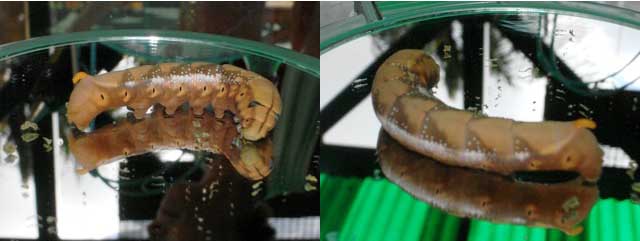
Deilaphila nerii fifth instar, brown form, Makawao, Maui, Hawaii,
August 7, 2012, courtesy of Kathleen Marchetti.
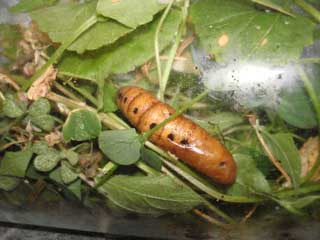
Deilaphila nerii pupa, Makawao, Maui, Hawaii,
August 8, 2012, courtesy of Kathleen Marchetti.
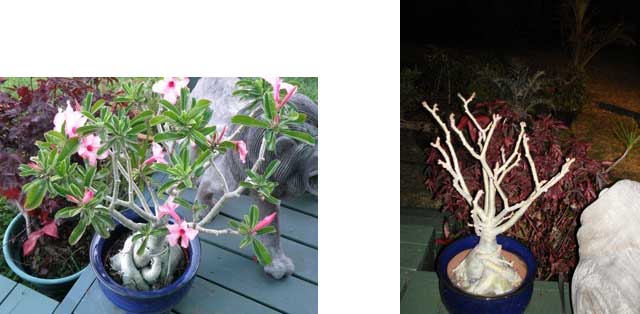
Bonsai desert rose tree, before and after, Makawao, Maui, Hawaii,
August 8, 2012, courtesy of Kathleen Marchetti.
Karen Christensen sends the following image from Hawaii, December 10, 2012:
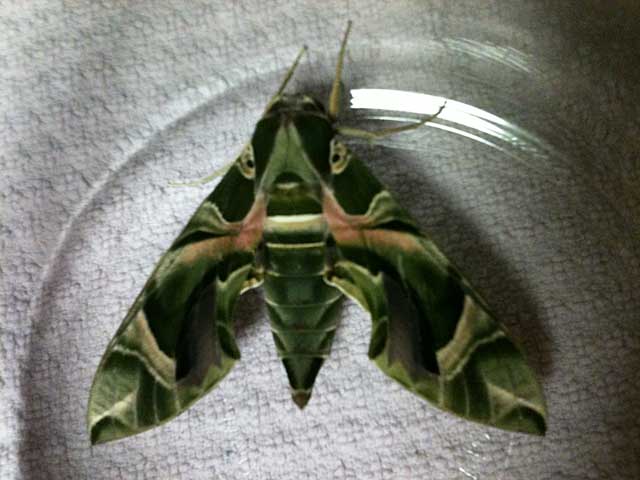
Deilephila nerii, Kanoehe, Oahu, Hawaii,
December 10, 2012, courtesy of Karen Christensen.
ECLOSION:
The 60--75mm pupa is "light brown, sprinkled with brown dots, particularly on wings and
abdominal segments. A black line runs up the proboscis, over the head and thorax, before fading away on darker coloured abdominal segments.
Cremaster short and straight. Spiracles set in a very dark brown, almost black spot. A crescent-shaped mark partly encircles each eye.
Formed in a loosely spun yellow cocoon among dry debris on the ground. Rarely survives European winters, but the main overwintering
stage throughout its resident range."
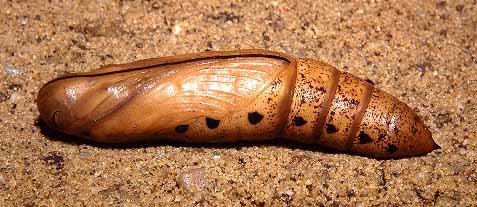
Pupa courtesy of Tony Pittaway.
SCENTING AND MATING:
"Pairing is a short affair usually lasting, at most, four hours but, occasionally, a couple will remain in copula until morning.
Rarely found at light, unlike D. hypothous ."
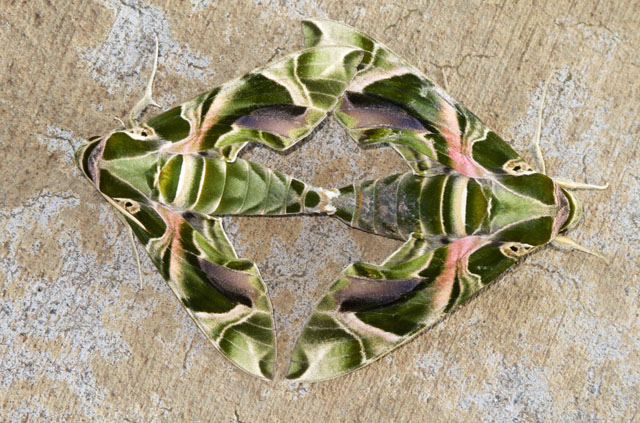
Deilephila nerii pairing, Kamuela, Big Island, Hawaii,
April 10, 2014, courtesy of Sherm Warner.
EGGS, LARVAE, PUPA:
The eggs are "almost spherical, small (1.50 x 1.25mm), light green. They are laid singly on both the upper and lower surfaces of
young leaves of isolated, preferably sheltered, bushes, especially those at the foot of cliffs or near houses, or in clearings amongst trees. Females
often fly around a plant several times before approaching with a pendulous flight. Most eggs take up to twelve days to hatch, but,
during hot weather, some hatch in only five."
"Newly-hatched larvae (3--4mm), which consume their eggshells, are bright yellow with an unusually long, very thin, blackish horn.
However, with feeding the yellow quickly assumes a greenish hue and, after the first moult, the primary colour becomes apple-green with a white dorso-lateral line
from abdominal segment 1 to the horn, a small, white eye-spot on the third thoracic segment, black spiracles and pink legs. With growth, the eye-spots become
blue with white centres, ringed in black. The horn has an unusual bulbous 'cap' until the penultimate instar. | 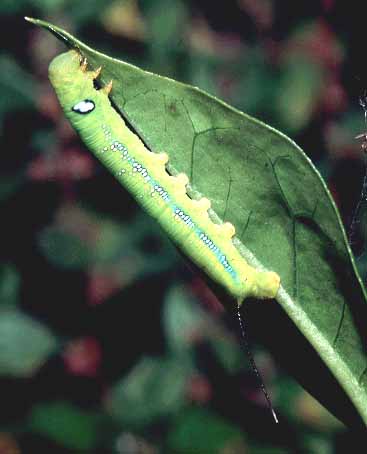 |
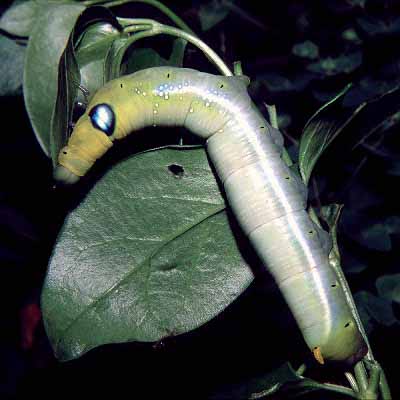 |
" Fully-grown larvae (100-130mm, brown or green forms) show little difference from younger ones, except for the change in eye-spots, and the horn losing its bulbous
cap and becoming orange with a black tip, finely warted, and downward curved. In some individuals the dorsal surface is rosy, while in most the dorso-lateral line
becomes edged in blue.
"In their final instar, some assume a bronze colour with rosy red anterior segments, which tends to mask the pre-pupation plum coloration; in all, however, the
newly acquired blue-black dorsal pigmentation, the now black eye-spots and unchanged white spots on either side of the dorso-lateral line remain prominent."
|
"When young, larvae feed fully exposed on the topmost leaves and flowers; when larger, they tend to conceal themselves further down the branches, or even, when not
feeding during daylight hours, on the ground under stones or leaf-litter. Those choosing to remain on the hostplant rest along the lower surface or stem of a leaf,
with the first four segments of the body slightly hunched. When first disturbed the caterpillar stretches out to resemble an oleander leaf. With further disturbance,
the anterior segments are arched up, suddenly revealing the startling eye-spots; at this point the noxious gut contents may also be regurgitated."
/center>
Melita Couta sends this beautiful image of a larva from Nicosia, Cyprus. She writes, "This is an image from what I found in my garden yesterday. It was a huge Surprise. I live in Nicosia, Cyprus. I have
about twelve of them eating my rododaphni fence but they are so gorgeous I can not stop them :)"
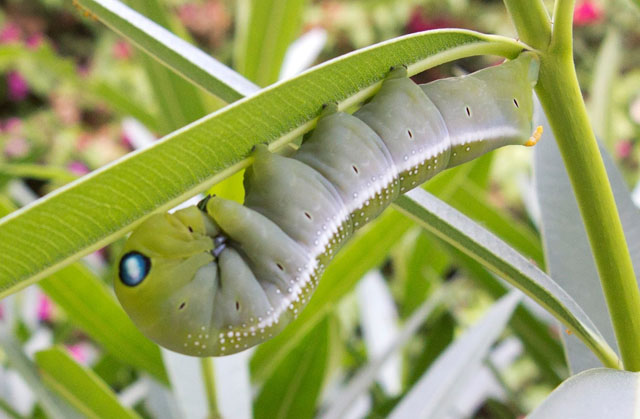
Deilephila nerii, on Nerium oleander, Nicosia, Cyprus,
June 13, 2014, courtesy of Melita Couta.
Sphingidae of Hawaii
Return to U. S. A. Table
Return to Sphingidae Index
Return to Macroglossini Tribe
This page is brought to you by Bill Oehlke and the
WLSS. Pages are on space rented from Bizland. If you would like to become a "Patron of the Sphingidae Site", contact Bill.
Please send sightings/images to Bill. I will do my best to respond to requests for identification help.

















